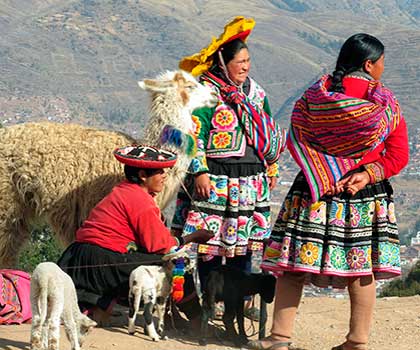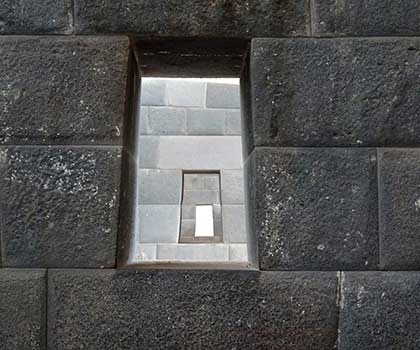Inca Culture & Incan Religion
Inca Culture
Each individual Inca citizen was given a strict task that they were to follow. This was determined based on their age, gender and social position. For example, children over five years of age had the responsibility of carrying water up to the fields where adults were harvesting crops. Women older than fifty were in charge of weaving cloth for making clothes. Even the physically and mentally disabled were given daily tasks that were attuned to their capabilities. An interesting task in the community was the chewing of the maize or corn and spitting it back into a big bowl. By letting this substance ferment the Inca made their own special corn beer called Chicha which they drank on festive occasions.
The bureaucrats, through a system called the Quipu, recorded each individual responsibility. It was an intricate form of communication using colored strings tied into knots. This was the Inca alternative to writing since they did not develop a written language of their own. Emperor Pachacuti also created religious holidays for his people. Six times a month the entire empire was shut down for festivities, lectures and parades.
The Inca people were amazing builders and architects. Their irrigation systems, palaces, temples, and fortifications can still be seen throughout the Andes. They had an efficient road system that was mainly used for government and military purposes and couriers would carry messages in the form of knotted cords all over the empire. Unfortunately, this road network was also used by the Spanish, which greatly facilitated their conquest of the Inca Empire.
Inca Ceremonies:
The Incan tribe was known for having different religious ceremonies based on their culture and on their customs. As a superstitious culture, the Incas were known for two ceremonial customs described below. These customs can still be seen being practiced by some of the local people in Peru today.
The coca leaf played a huge role in the Inca culture centuries ago. The Incas believed that it was actually possible to tell the future based on a reading of the coca leaves.
The ancient Peruvian cultures had the need to not only understand what would occur in their future, but to prevent anything threatening that may happen to it. For this reason they used to consult the coca leaves often believing their futures would be told. The coca leaf was sacred to them and the priest often conducted the ceremony. This ritual enabled the people to understand what the Pacha Mama or “mother earth” had in store for them. This ritual can still be found in the areas of Cusco and the surrounding Sacred Valley today.
The second and more familiar tribute that the Incas practiced was the homage given to the Mother Earth.
The ancient Peruvians had a grand respect for the earth and understood its natural elements. They believed that the Mother Earth was the maker of everything that exists (animals, plants, human beings, ants and spirits).
When natural disasters happened or if the people wanted to petition for something special in their lives, they would use a mystic ceremony with symbolic content. They paid tribute to the Mother Earth.


Incan Religion
Pachacuti was a key influence on the drastic reorganization of the Inca religion. He claimed to be the direct descendant of the Inca Sun God Inti, which brought strict obedience from his people. Their daily work tasks almost became a religious duty as Pachacuti created a cult around himself and the sun-god Inti.
Every day the emperor would wear new clothes and have his old ones from the previous day burned. Meals would only be eaten from his golden plates. He believed himself to be an actual god.
Inca society was a theocratic society, meaning that politics and religion were completely intertwined. The Inca religion combined many features of animism, fetishism, and the worship of nature gods representing forces of nature. Through these rituals, the Incas practiced forms of divination and the sacrifice of humans and animals.